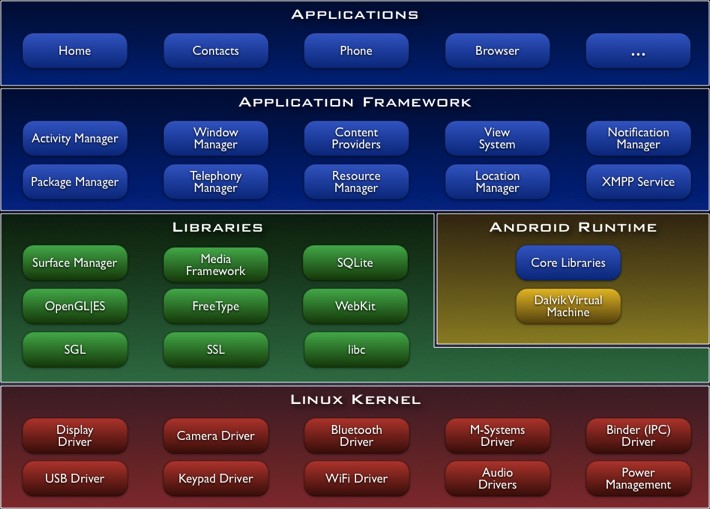Android OS Customization

Android Architecture

Android is an operating system based on the Linux kernel, and designed primarily for touchscreen mobile devices such as smartphones and tablet computers. On top of the Linux kernel, there are the middleware, libraries and APIs written in C, and application software running on an application framework which includes Java-compatible libraries based on Apache Harmony. It’s comprised of four layers structure what are the kernel layer, runtime layer, framework layer and application layer.
- Linux Kernel
The use of Android is including the standard Linux kernel and some peripheral drivers.
- Libraries and Android Run Time
Android includes a set of C/C++ libraries which can be used in various components of Android. These functions are presented to developers through Android application framework. Android contains a group of core library at runtime which has provides the most functions of the Java language core libraries.
- Application Framework
Android application is formed of one or more components. Android Framework has provided APIs to application developers which are actually a framework of an application. The upper-layer application is built in Java so this layer first includes a variety of controls which are needed in UI programs.
- Application
Android application is mainly for User Interface and usually written in Java. It can also include various resource files (located in res folder) Java program and a APK package created after compiling some resources. Android itself has provided many core applications such as Home, Contact, Phone, Browsers and etc. Meanwhile the developer can also use the API of the application framework layer to implement their own applications.
Between Android’s four layers, the application layer call from the libraries that are used through framework layer. The kernel is in charge of memory management and process scheduling. We can remove parts of functions through tailoring on different layers. For example, if removing APK from application layer, we cannot use relative applications then; if removing needed library files from Run Time layer, it will report errors and cannot execute when calling these library files; we can also achieve the same goal through compiling kernel using “config” on kernel layer.
We offer Android OS customization service to customers with the aims below:
- Simplify system and improve the system efficiency
Android OS has provided many standard drivers and middleware which makes much more convenient for developers to develop applications and effectively reduce the development time, improve design efficiency. But on the other hand, the system becomes bloated. For some special equipment, the more portable of the system, the better the stability and the quicker the system response. So the customization service can help simplify codes, improve the efficiency of the system and shorten the startup time.
- Support special hardware
We usually use some special hardware in embedded applications. The special hardware must have specific driver, so we need to customize the driver.
- Provide professional Human-Computer Interface
For some special equipment, we need only to run an application for most of the time. For these kinds of application systems, it is no need traditional Android interface to support. So it needs a customized special interface for the applications which can make the product more professional.
- Develop special applications
The application development is part of Android system. We need to develop special applications for special equipment to finish the whole product design.
Android OS Customization Service Items
Item |
Description |
Tailoring and Customization of Linux Kernel |
The Android OS is using standard Linux kernel. To select suitable Linux kernel version for customization and development is the first step of Android OS customization. |
Driver development |
Develop drivers according to actual requirement. Remove the common-used drivers in Android to make Linux kernel simple and effective. |
Porting of file system |
Android itself is a customized file system based on the Linux
kernel. So the porting of file system is an important test of Android system. |
Set up development platform |
For Android development, we need to add more development components which are used specially for android based on Linux development platform so that the Android applications are easy to develop. |
Tailoring and Customization of MiddleWare |
The MiddleWare is plus-in between the Android system and applications. Many standard MiddleWares can be removed according to the requirement of the applications’ functions so as to make the whole Android system simplified. |
UI customization |
UI can mostly reflect the advantages of Android development. It can use the commonly-used Android interface but also can be customized including the boot logo, startup interface and etc. Especially for the self-service terminals in publics, the UI customization service can greatly increase the degree of specialization. |
Application Development |
Application development is the last part of Linux project. We need to complete hardware resource allocation and implement the functions according to users’ application requirements. |
After-sales service and
technical support |
The after-sales service and technical support is after the project closed. This is to ensure the service assurance. The complete after-sales service and technical support work is an important factor for customers to select their partners. |
Android Applications

|